Analysis of Success Factors for ERP Implementation: Omantel Case Study
VerifiedAdded on 2020/04/21
|11
|2687
|82
Case Study
AI Summary
This case study examines the success factors for ERP implementation within the Middle East region, using Omantel, a telecommunications company in Oman, as a primary example. The study highlights the differences between ERP implementation in the public and private sectors, emphasizing the importance of top management support, project management, and business process re-engineering as critical success factors. The analysis delves into Omantel's implementation methodology, including stakeholder consultation, vendor selection, and project management phases, while also addressing the challenges faced, such as extended implementation timelines and stakeholder engagement. The paper concludes with recommendations for hybrid ERP implementation and underscores the significance of risk management and careful ERP package selection to ensure successful outcomes. The revenue of Omantel increased year by year for successful management with the help of ERP system. The study helps to assess ERP implementation strategy in Omantel as well as finally find a perfect ERP implementation strategy, which will not impinge on business of the organization while implementing the strategy.
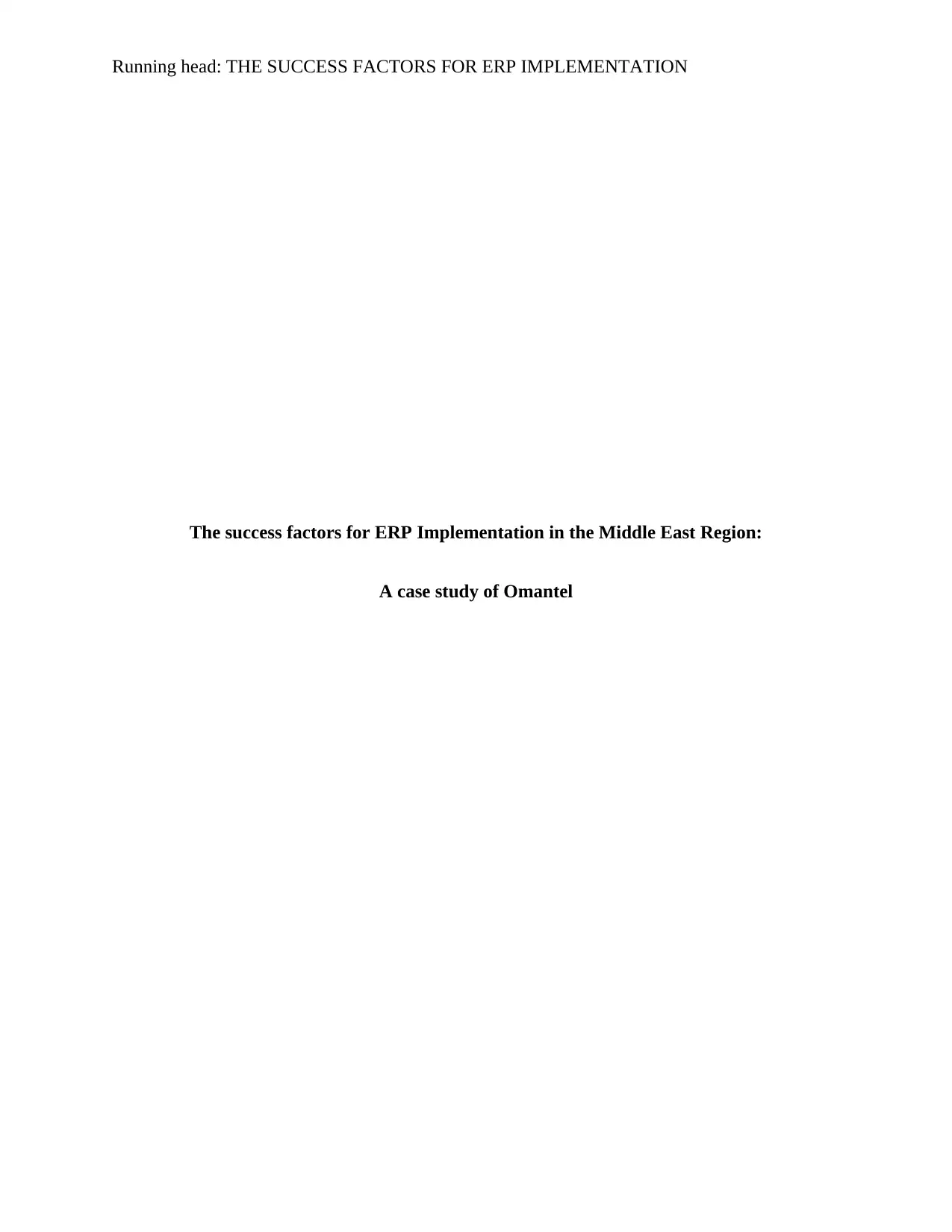
Running head: THE SUCCESS FACTORS FOR ERP IMPLEMENTATION
The success factors for ERP Implementation in the Middle East Region:
A case study of Omantel
The success factors for ERP Implementation in the Middle East Region:
A case study of Omantel
Paraphrase This Document
Need a fresh take? Get an instant paraphrase of this document with our AI Paraphraser
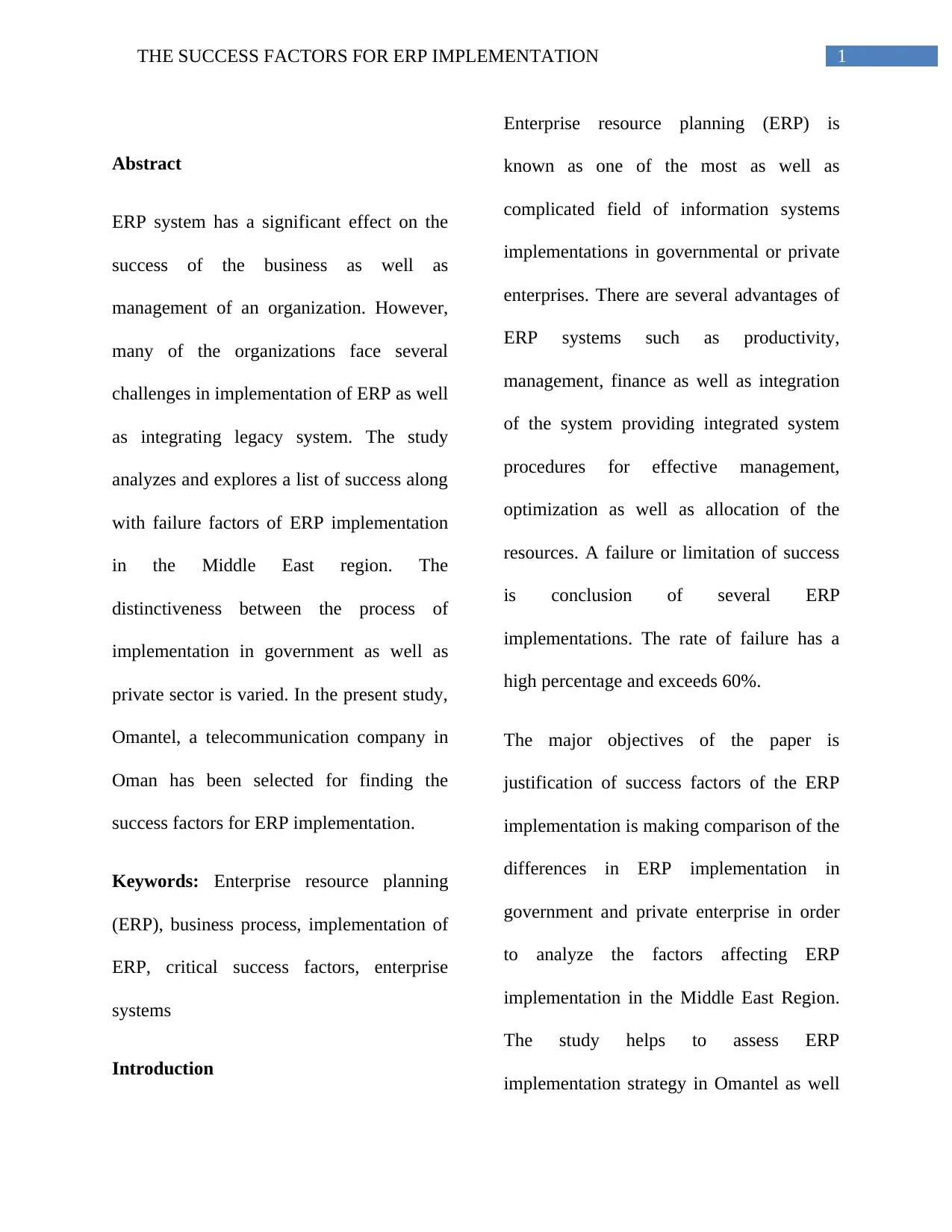
1THE SUCCESS FACTORS FOR ERP IMPLEMENTATION
Abstract
ERP system has a significant effect on the
success of the business as well as
management of an organization. However,
many of the organizations face several
challenges in implementation of ERP as well
as integrating legacy system. The study
analyzes and explores a list of success along
with failure factors of ERP implementation
in the Middle East region. The
distinctiveness between the process of
implementation in government as well as
private sector is varied. In the present study,
Omantel, a telecommunication company in
Oman has been selected for finding the
success factors for ERP implementation.
Keywords: Enterprise resource planning
(ERP), business process, implementation of
ERP, critical success factors, enterprise
systems
Introduction
Enterprise resource planning (ERP) is
known as one of the most as well as
complicated field of information systems
implementations in governmental or private
enterprises. There are several advantages of
ERP systems such as productivity,
management, finance as well as integration
of the system providing integrated system
procedures for effective management,
optimization as well as allocation of the
resources. A failure or limitation of success
is conclusion of several ERP
implementations. The rate of failure has a
high percentage and exceeds 60%.
The major objectives of the paper is
justification of success factors of the ERP
implementation is making comparison of the
differences in ERP implementation in
government and private enterprise in order
to analyze the factors affecting ERP
implementation in the Middle East Region.
The study helps to assess ERP
implementation strategy in Omantel as well
Abstract
ERP system has a significant effect on the
success of the business as well as
management of an organization. However,
many of the organizations face several
challenges in implementation of ERP as well
as integrating legacy system. The study
analyzes and explores a list of success along
with failure factors of ERP implementation
in the Middle East region. The
distinctiveness between the process of
implementation in government as well as
private sector is varied. In the present study,
Omantel, a telecommunication company in
Oman has been selected for finding the
success factors for ERP implementation.
Keywords: Enterprise resource planning
(ERP), business process, implementation of
ERP, critical success factors, enterprise
systems
Introduction
Enterprise resource planning (ERP) is
known as one of the most as well as
complicated field of information systems
implementations in governmental or private
enterprises. There are several advantages of
ERP systems such as productivity,
management, finance as well as integration
of the system providing integrated system
procedures for effective management,
optimization as well as allocation of the
resources. A failure or limitation of success
is conclusion of several ERP
implementations. The rate of failure has a
high percentage and exceeds 60%.
The major objectives of the paper is
justification of success factors of the ERP
implementation is making comparison of the
differences in ERP implementation in
government and private enterprise in order
to analyze the factors affecting ERP
implementation in the Middle East Region.
The study helps to assess ERP
implementation strategy in Omantel as well
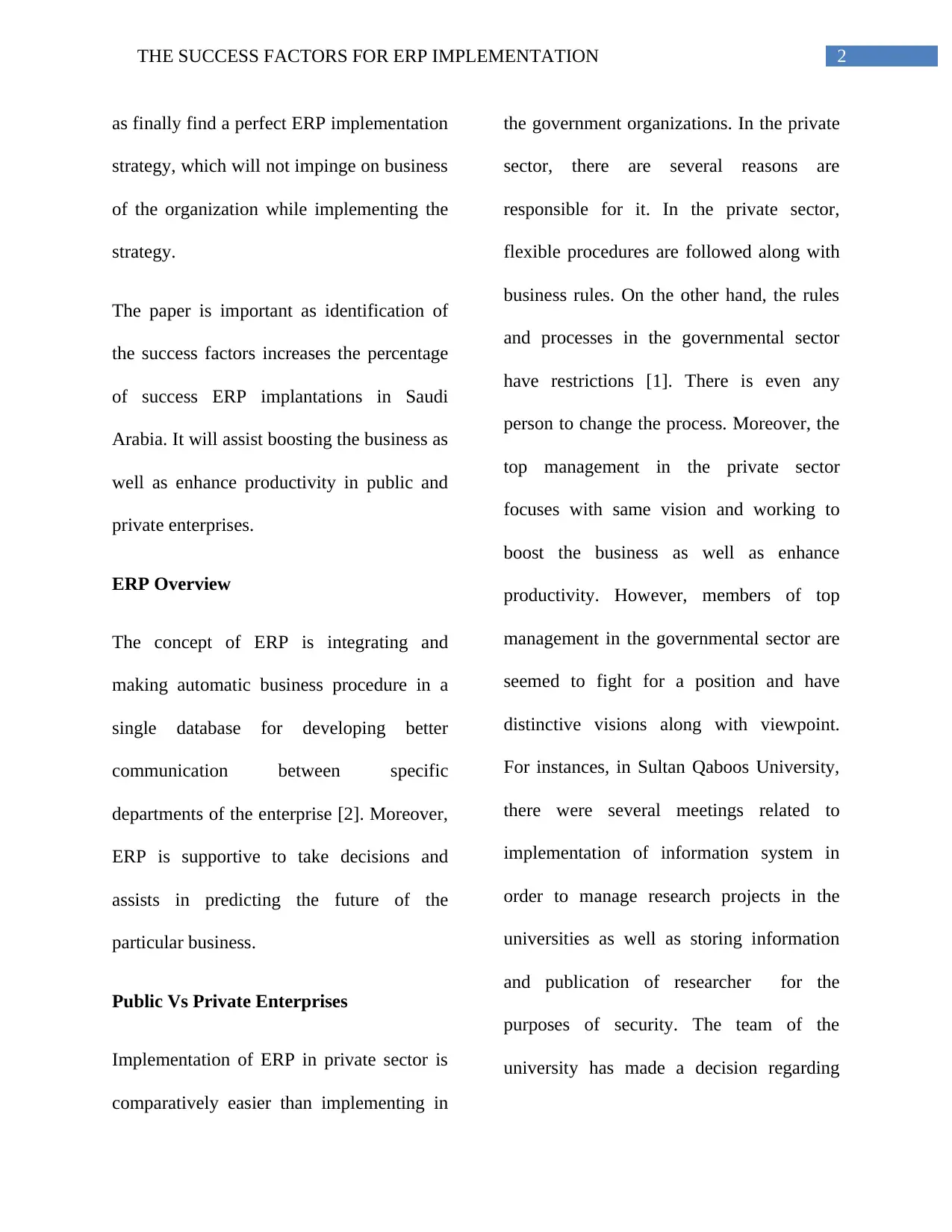
2THE SUCCESS FACTORS FOR ERP IMPLEMENTATION
as finally find a perfect ERP implementation
strategy, which will not impinge on business
of the organization while implementing the
strategy.
The paper is important as identification of
the success factors increases the percentage
of success ERP implantations in Saudi
Arabia. It will assist boosting the business as
well as enhance productivity in public and
private enterprises.
ERP Overview
The concept of ERP is integrating and
making automatic business procedure in a
single database for developing better
communication between specific
departments of the enterprise [2]. Moreover,
ERP is supportive to take decisions and
assists in predicting the future of the
particular business.
Public Vs Private Enterprises
Implementation of ERP in private sector is
comparatively easier than implementing in
the government organizations. In the private
sector, there are several reasons are
responsible for it. In the private sector,
flexible procedures are followed along with
business rules. On the other hand, the rules
and processes in the governmental sector
have restrictions [1]. There is even any
person to change the process. Moreover, the
top management in the private sector
focuses with same vision and working to
boost the business as well as enhance
productivity. However, members of top
management in the governmental sector are
seemed to fight for a position and have
distinctive visions along with viewpoint.
For instances, in Sultan Qaboos University,
there were several meetings related to
implementation of information system in
order to manage research projects in the
universities as well as storing information
and publication of researcher for the
purposes of security. The team of the
university has made a decision regarding
as finally find a perfect ERP implementation
strategy, which will not impinge on business
of the organization while implementing the
strategy.
The paper is important as identification of
the success factors increases the percentage
of success ERP implantations in Saudi
Arabia. It will assist boosting the business as
well as enhance productivity in public and
private enterprises.
ERP Overview
The concept of ERP is integrating and
making automatic business procedure in a
single database for developing better
communication between specific
departments of the enterprise [2]. Moreover,
ERP is supportive to take decisions and
assists in predicting the future of the
particular business.
Public Vs Private Enterprises
Implementation of ERP in private sector is
comparatively easier than implementing in
the government organizations. In the private
sector, there are several reasons are
responsible for it. In the private sector,
flexible procedures are followed along with
business rules. On the other hand, the rules
and processes in the governmental sector
have restrictions [1]. There is even any
person to change the process. Moreover, the
top management in the private sector
focuses with same vision and working to
boost the business as well as enhance
productivity. However, members of top
management in the governmental sector are
seemed to fight for a position and have
distinctive visions along with viewpoint.
For instances, in Sultan Qaboos University,
there were several meetings related to
implementation of information system in
order to manage research projects in the
universities as well as storing information
and publication of researcher for the
purposes of security. The team of the
university has made a decision regarding
⊘ This is a preview!⊘
Do you want full access?
Subscribe today to unlock all pages.

Trusted by 1+ million students worldwide
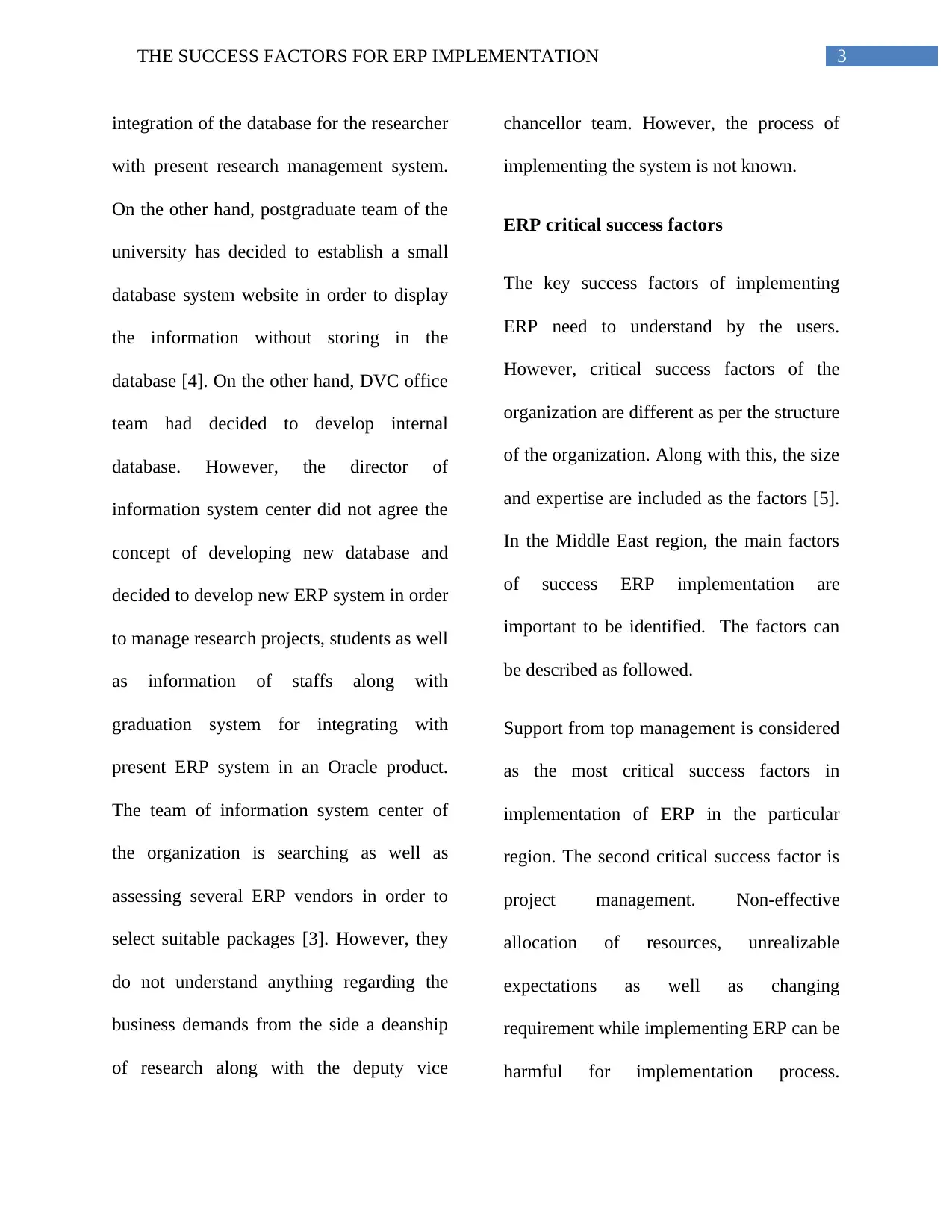
3THE SUCCESS FACTORS FOR ERP IMPLEMENTATION
integration of the database for the researcher
with present research management system.
On the other hand, postgraduate team of the
university has decided to establish a small
database system website in order to display
the information without storing in the
database [4]. On the other hand, DVC office
team had decided to develop internal
database. However, the director of
information system center did not agree the
concept of developing new database and
decided to develop new ERP system in order
to manage research projects, students as well
as information of staffs along with
graduation system for integrating with
present ERP system in an Oracle product.
The team of information system center of
the organization is searching as well as
assessing several ERP vendors in order to
select suitable packages [3]. However, they
do not understand anything regarding the
business demands from the side a deanship
of research along with the deputy vice
chancellor team. However, the process of
implementing the system is not known.
ERP critical success factors
The key success factors of implementing
ERP need to understand by the users.
However, critical success factors of the
organization are different as per the structure
of the organization. Along with this, the size
and expertise are included as the factors [5].
In the Middle East region, the main factors
of success ERP implementation are
important to be identified. The factors can
be described as followed.
Support from top management is considered
as the most critical success factors in
implementation of ERP in the particular
region. The second critical success factor is
project management. Non-effective
allocation of resources, unrealizable
expectations as well as changing
requirement while implementing ERP can be
harmful for implementation process.
integration of the database for the researcher
with present research management system.
On the other hand, postgraduate team of the
university has decided to establish a small
database system website in order to display
the information without storing in the
database [4]. On the other hand, DVC office
team had decided to develop internal
database. However, the director of
information system center did not agree the
concept of developing new database and
decided to develop new ERP system in order
to manage research projects, students as well
as information of staffs along with
graduation system for integrating with
present ERP system in an Oracle product.
The team of information system center of
the organization is searching as well as
assessing several ERP vendors in order to
select suitable packages [3]. However, they
do not understand anything regarding the
business demands from the side a deanship
of research along with the deputy vice
chancellor team. However, the process of
implementing the system is not known.
ERP critical success factors
The key success factors of implementing
ERP need to understand by the users.
However, critical success factors of the
organization are different as per the structure
of the organization. Along with this, the size
and expertise are included as the factors [5].
In the Middle East region, the main factors
of success ERP implementation are
important to be identified. The factors can
be described as followed.
Support from top management is considered
as the most critical success factors in
implementation of ERP in the particular
region. The second critical success factor is
project management. Non-effective
allocation of resources, unrealizable
expectations as well as changing
requirement while implementing ERP can be
harmful for implementation process.
Paraphrase This Document
Need a fresh take? Get an instant paraphrase of this document with our AI Paraphraser
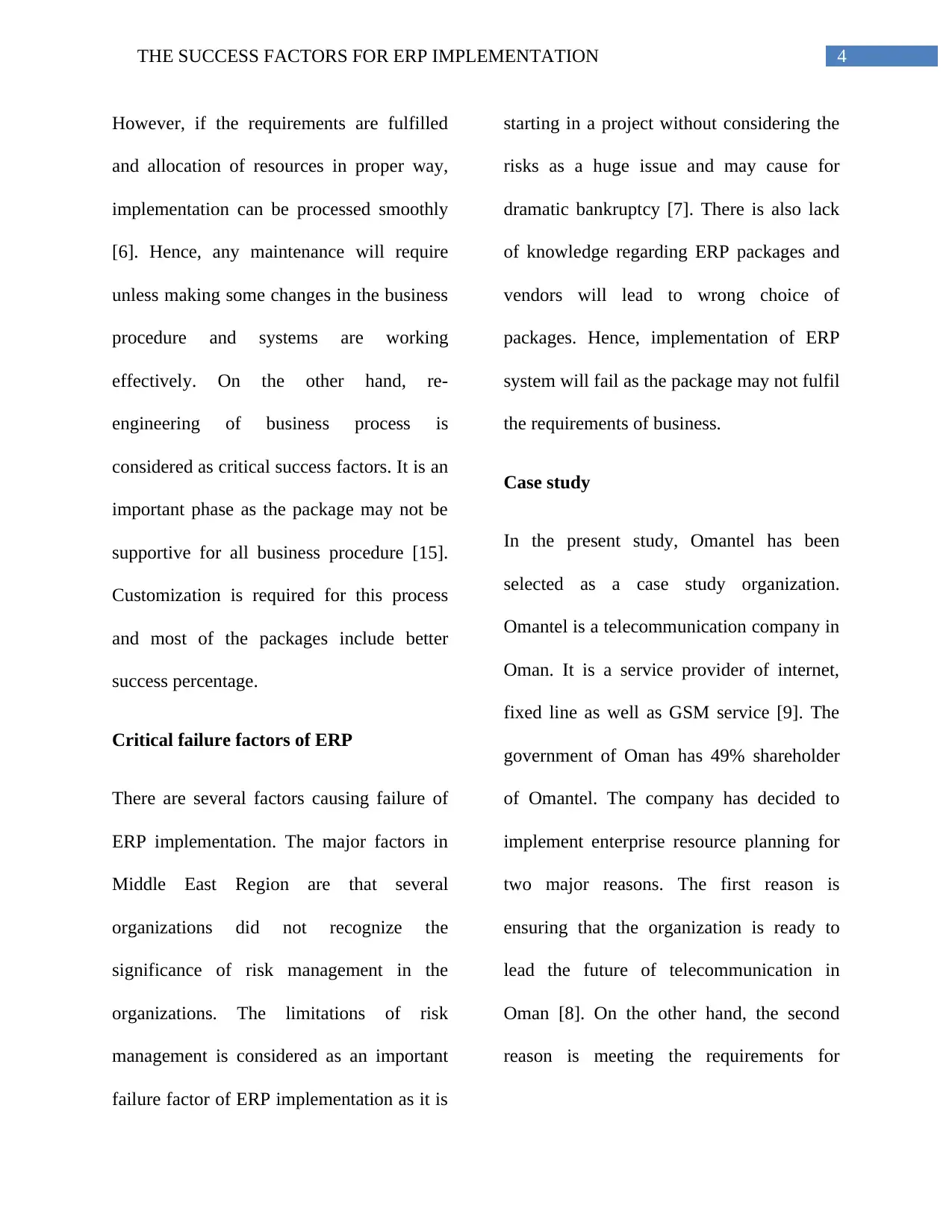
4THE SUCCESS FACTORS FOR ERP IMPLEMENTATION
However, if the requirements are fulfilled
and allocation of resources in proper way,
implementation can be processed smoothly
[6]. Hence, any maintenance will require
unless making some changes in the business
procedure and systems are working
effectively. On the other hand, re-
engineering of business process is
considered as critical success factors. It is an
important phase as the package may not be
supportive for all business procedure [15].
Customization is required for this process
and most of the packages include better
success percentage.
Critical failure factors of ERP
There are several factors causing failure of
ERP implementation. The major factors in
Middle East Region are that several
organizations did not recognize the
significance of risk management in the
organizations. The limitations of risk
management is considered as an important
failure factor of ERP implementation as it is
starting in a project without considering the
risks as a huge issue and may cause for
dramatic bankruptcy [7]. There is also lack
of knowledge regarding ERP packages and
vendors will lead to wrong choice of
packages. Hence, implementation of ERP
system will fail as the package may not fulfil
the requirements of business.
Case study
In the present study, Omantel has been
selected as a case study organization.
Omantel is a telecommunication company in
Oman. It is a service provider of internet,
fixed line as well as GSM service [9]. The
government of Oman has 49% shareholder
of Omantel. The company has decided to
implement enterprise resource planning for
two major reasons. The first reason is
ensuring that the organization is ready to
lead the future of telecommunication in
Oman [8]. On the other hand, the second
reason is meeting the requirements for
However, if the requirements are fulfilled
and allocation of resources in proper way,
implementation can be processed smoothly
[6]. Hence, any maintenance will require
unless making some changes in the business
procedure and systems are working
effectively. On the other hand, re-
engineering of business process is
considered as critical success factors. It is an
important phase as the package may not be
supportive for all business procedure [15].
Customization is required for this process
and most of the packages include better
success percentage.
Critical failure factors of ERP
There are several factors causing failure of
ERP implementation. The major factors in
Middle East Region are that several
organizations did not recognize the
significance of risk management in the
organizations. The limitations of risk
management is considered as an important
failure factor of ERP implementation as it is
starting in a project without considering the
risks as a huge issue and may cause for
dramatic bankruptcy [7]. There is also lack
of knowledge regarding ERP packages and
vendors will lead to wrong choice of
packages. Hence, implementation of ERP
system will fail as the package may not fulfil
the requirements of business.
Case study
In the present study, Omantel has been
selected as a case study organization.
Omantel is a telecommunication company in
Oman. It is a service provider of internet,
fixed line as well as GSM service [9]. The
government of Oman has 49% shareholder
of Omantel. The company has decided to
implement enterprise resource planning for
two major reasons. The first reason is
ensuring that the organization is ready to
lead the future of telecommunication in
Oman [8]. On the other hand, the second
reason is meeting the requirements for
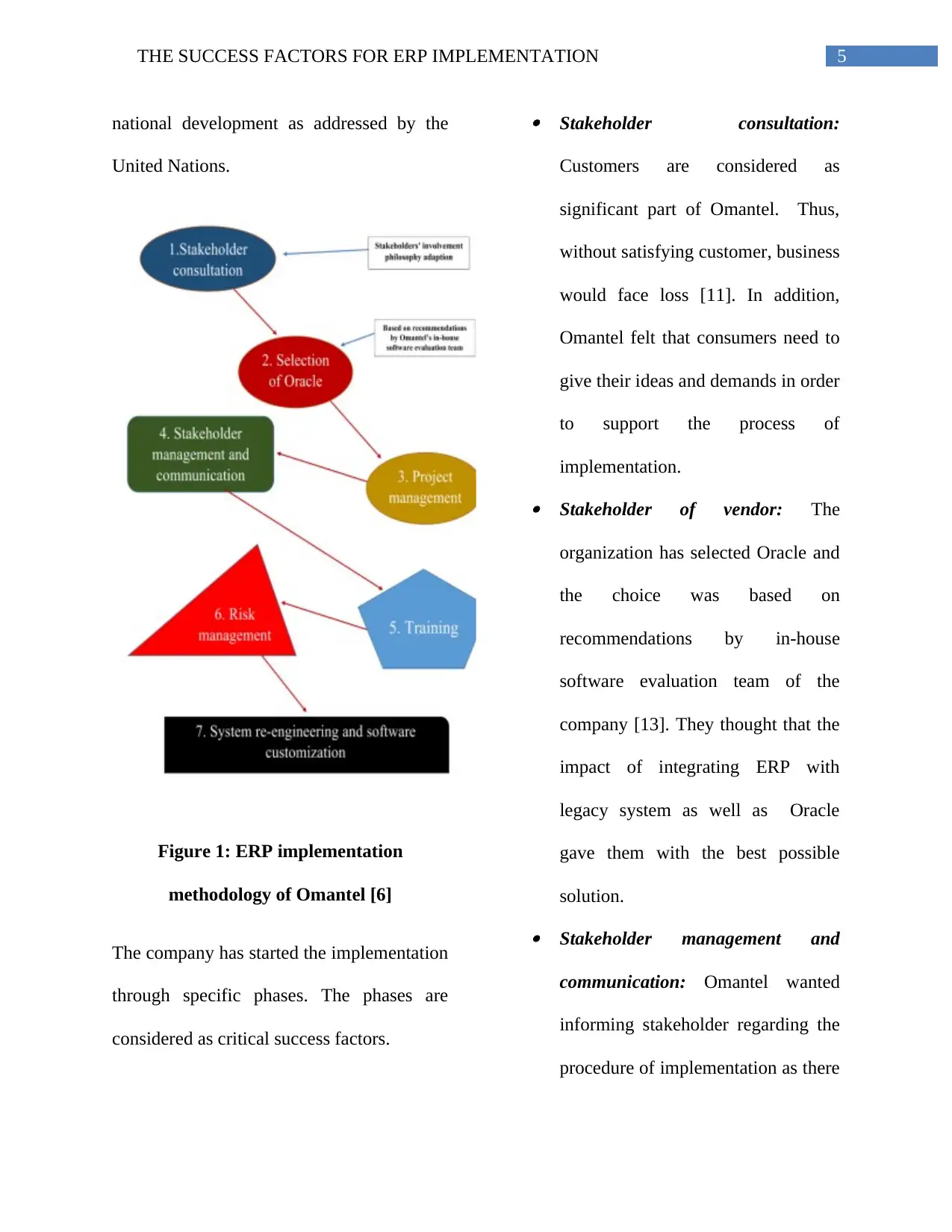
5THE SUCCESS FACTORS FOR ERP IMPLEMENTATION
national development as addressed by the
United Nations.
Figure 1: ERP implementation
methodology of Omantel [6]
The company has started the implementation
through specific phases. The phases are
considered as critical success factors.
Stakeholder consultation:
Customers are considered as
significant part of Omantel. Thus,
without satisfying customer, business
would face loss [11]. In addition,
Omantel felt that consumers need to
give their ideas and demands in order
to support the process of
implementation.
Stakeholder of vendor: The
organization has selected Oracle and
the choice was based on
recommendations by in-house
software evaluation team of the
company [13]. They thought that the
impact of integrating ERP with
legacy system as well as Oracle
gave them with the best possible
solution.
Stakeholder management and
communication: Omantel wanted
informing stakeholder regarding the
procedure of implementation as there
national development as addressed by the
United Nations.
Figure 1: ERP implementation
methodology of Omantel [6]
The company has started the implementation
through specific phases. The phases are
considered as critical success factors.
Stakeholder consultation:
Customers are considered as
significant part of Omantel. Thus,
without satisfying customer, business
would face loss [11]. In addition,
Omantel felt that consumers need to
give their ideas and demands in order
to support the process of
implementation.
Stakeholder of vendor: The
organization has selected Oracle and
the choice was based on
recommendations by in-house
software evaluation team of the
company [13]. They thought that the
impact of integrating ERP with
legacy system as well as Oracle
gave them with the best possible
solution.
Stakeholder management and
communication: Omantel wanted
informing stakeholder regarding the
procedure of implementation as there
⊘ This is a preview!⊘
Do you want full access?
Subscribe today to unlock all pages.

Trusted by 1+ million students worldwide
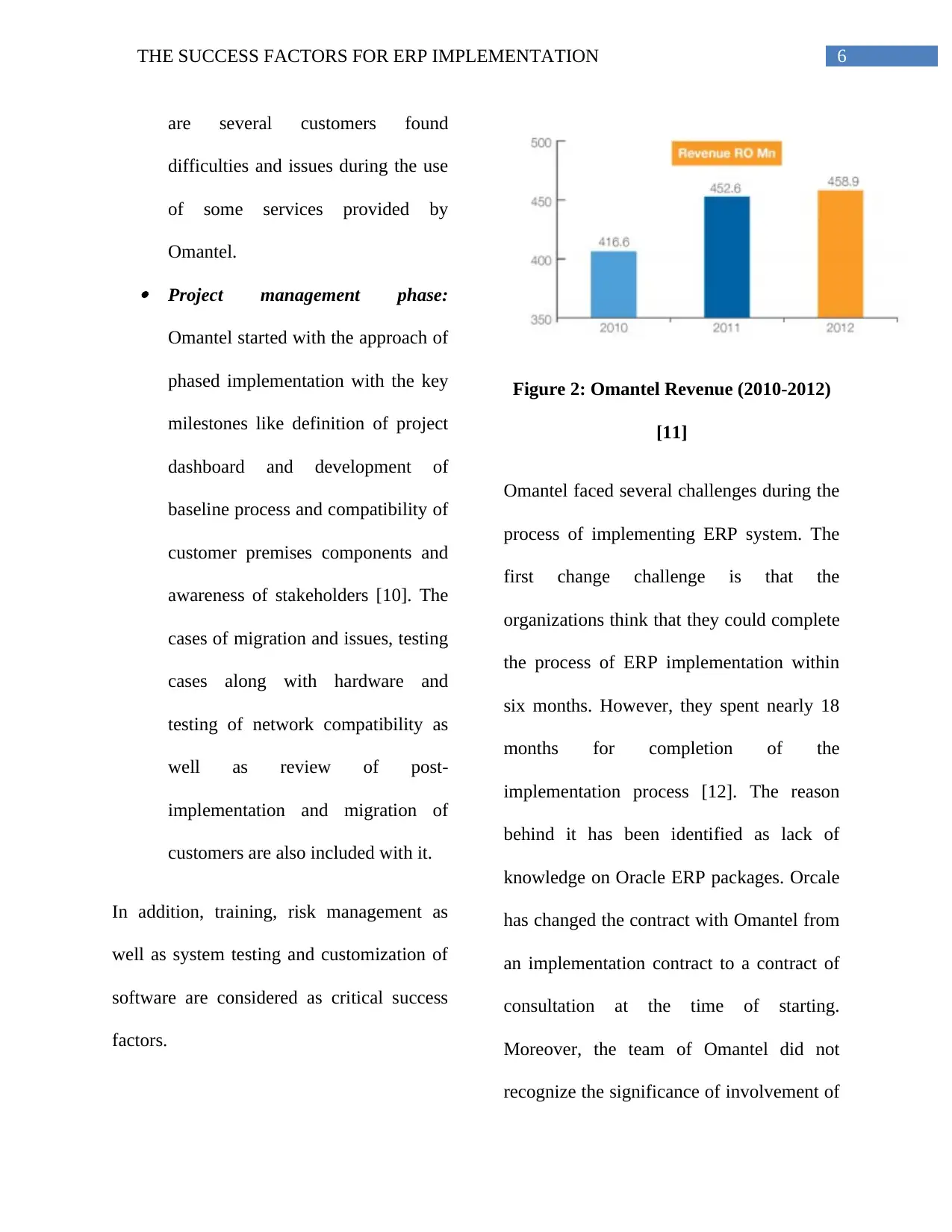
6THE SUCCESS FACTORS FOR ERP IMPLEMENTATION
are several customers found
difficulties and issues during the use
of some services provided by
Omantel. Project management phase:
Omantel started with the approach of
phased implementation with the key
milestones like definition of project
dashboard and development of
baseline process and compatibility of
customer premises components and
awareness of stakeholders [10]. The
cases of migration and issues, testing
cases along with hardware and
testing of network compatibility as
well as review of post-
implementation and migration of
customers are also included with it.
In addition, training, risk management as
well as system testing and customization of
software are considered as critical success
factors.
Figure 2: Omantel Revenue (2010-2012)
[11]
Omantel faced several challenges during the
process of implementing ERP system. The
first change challenge is that the
organizations think that they could complete
the process of ERP implementation within
six months. However, they spent nearly 18
months for completion of the
implementation process [12]. The reason
behind it has been identified as lack of
knowledge on Oracle ERP packages. Orcale
has changed the contract with Omantel from
an implementation contract to a contract of
consultation at the time of starting.
Moreover, the team of Omantel did not
recognize the significance of involvement of
are several customers found
difficulties and issues during the use
of some services provided by
Omantel. Project management phase:
Omantel started with the approach of
phased implementation with the key
milestones like definition of project
dashboard and development of
baseline process and compatibility of
customer premises components and
awareness of stakeholders [10]. The
cases of migration and issues, testing
cases along with hardware and
testing of network compatibility as
well as review of post-
implementation and migration of
customers are also included with it.
In addition, training, risk management as
well as system testing and customization of
software are considered as critical success
factors.
Figure 2: Omantel Revenue (2010-2012)
[11]
Omantel faced several challenges during the
process of implementing ERP system. The
first change challenge is that the
organizations think that they could complete
the process of ERP implementation within
six months. However, they spent nearly 18
months for completion of the
implementation process [12]. The reason
behind it has been identified as lack of
knowledge on Oracle ERP packages. Orcale
has changed the contract with Omantel from
an implementation contract to a contract of
consultation at the time of starting.
Moreover, the team of Omantel did not
recognize the significance of involvement of
Paraphrase This Document
Need a fresh take? Get an instant paraphrase of this document with our AI Paraphraser
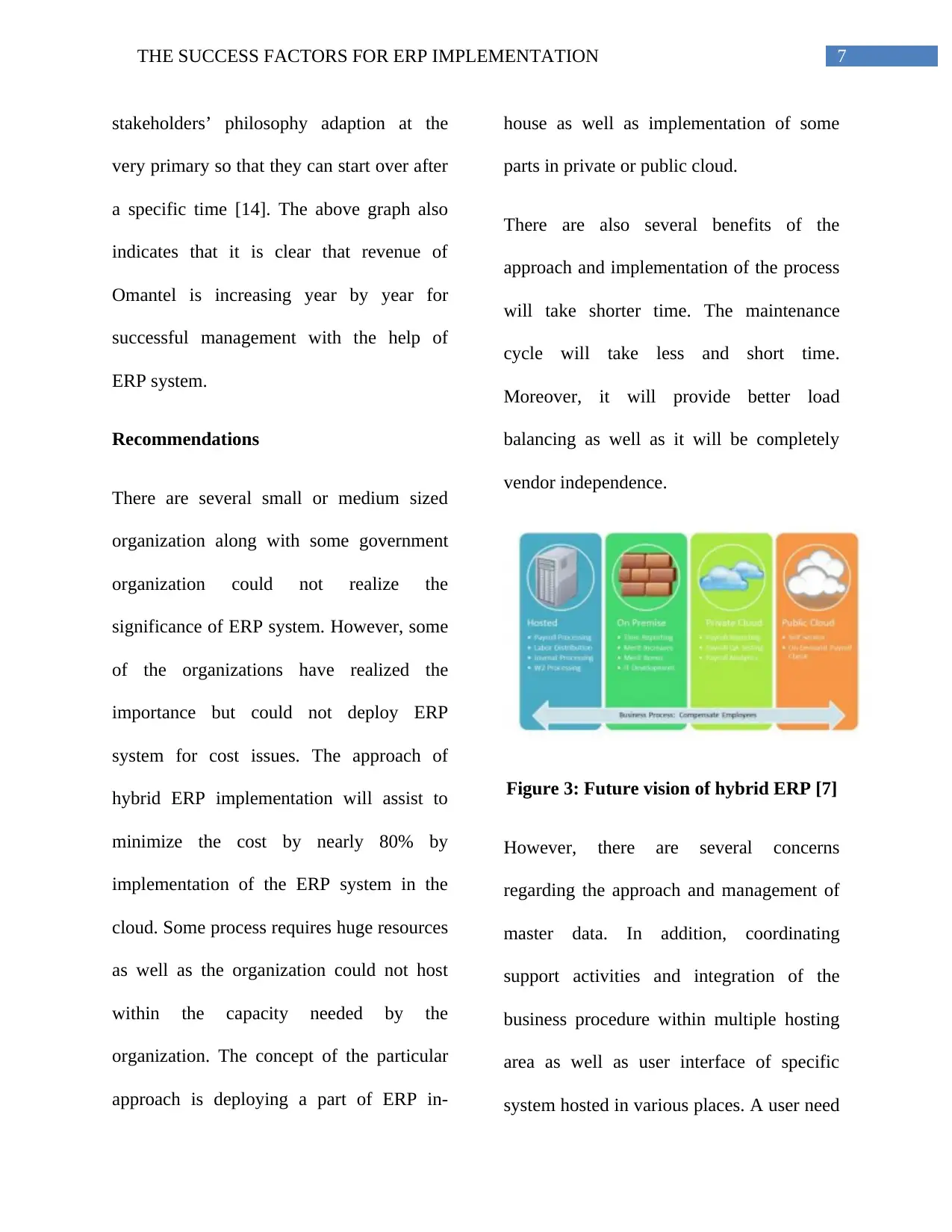
7THE SUCCESS FACTORS FOR ERP IMPLEMENTATION
stakeholders’ philosophy adaption at the
very primary so that they can start over after
a specific time [14]. The above graph also
indicates that it is clear that revenue of
Omantel is increasing year by year for
successful management with the help of
ERP system.
Recommendations
There are several small or medium sized
organization along with some government
organization could not realize the
significance of ERP system. However, some
of the organizations have realized the
importance but could not deploy ERP
system for cost issues. The approach of
hybrid ERP implementation will assist to
minimize the cost by nearly 80% by
implementation of the ERP system in the
cloud. Some process requires huge resources
as well as the organization could not host
within the capacity needed by the
organization. The concept of the particular
approach is deploying a part of ERP in-
house as well as implementation of some
parts in private or public cloud.
There are also several benefits of the
approach and implementation of the process
will take shorter time. The maintenance
cycle will take less and short time.
Moreover, it will provide better load
balancing as well as it will be completely
vendor independence.
Figure 3: Future vision of hybrid ERP [7]
However, there are several concerns
regarding the approach and management of
master data. In addition, coordinating
support activities and integration of the
business procedure within multiple hosting
area as well as user interface of specific
system hosted in various places. A user need
stakeholders’ philosophy adaption at the
very primary so that they can start over after
a specific time [14]. The above graph also
indicates that it is clear that revenue of
Omantel is increasing year by year for
successful management with the help of
ERP system.
Recommendations
There are several small or medium sized
organization along with some government
organization could not realize the
significance of ERP system. However, some
of the organizations have realized the
importance but could not deploy ERP
system for cost issues. The approach of
hybrid ERP implementation will assist to
minimize the cost by nearly 80% by
implementation of the ERP system in the
cloud. Some process requires huge resources
as well as the organization could not host
within the capacity needed by the
organization. The concept of the particular
approach is deploying a part of ERP in-
house as well as implementation of some
parts in private or public cloud.
There are also several benefits of the
approach and implementation of the process
will take shorter time. The maintenance
cycle will take less and short time.
Moreover, it will provide better load
balancing as well as it will be completely
vendor independence.
Figure 3: Future vision of hybrid ERP [7]
However, there are several concerns
regarding the approach and management of
master data. In addition, coordinating
support activities and integration of the
business procedure within multiple hosting
area as well as user interface of specific
system hosted in various places. A user need
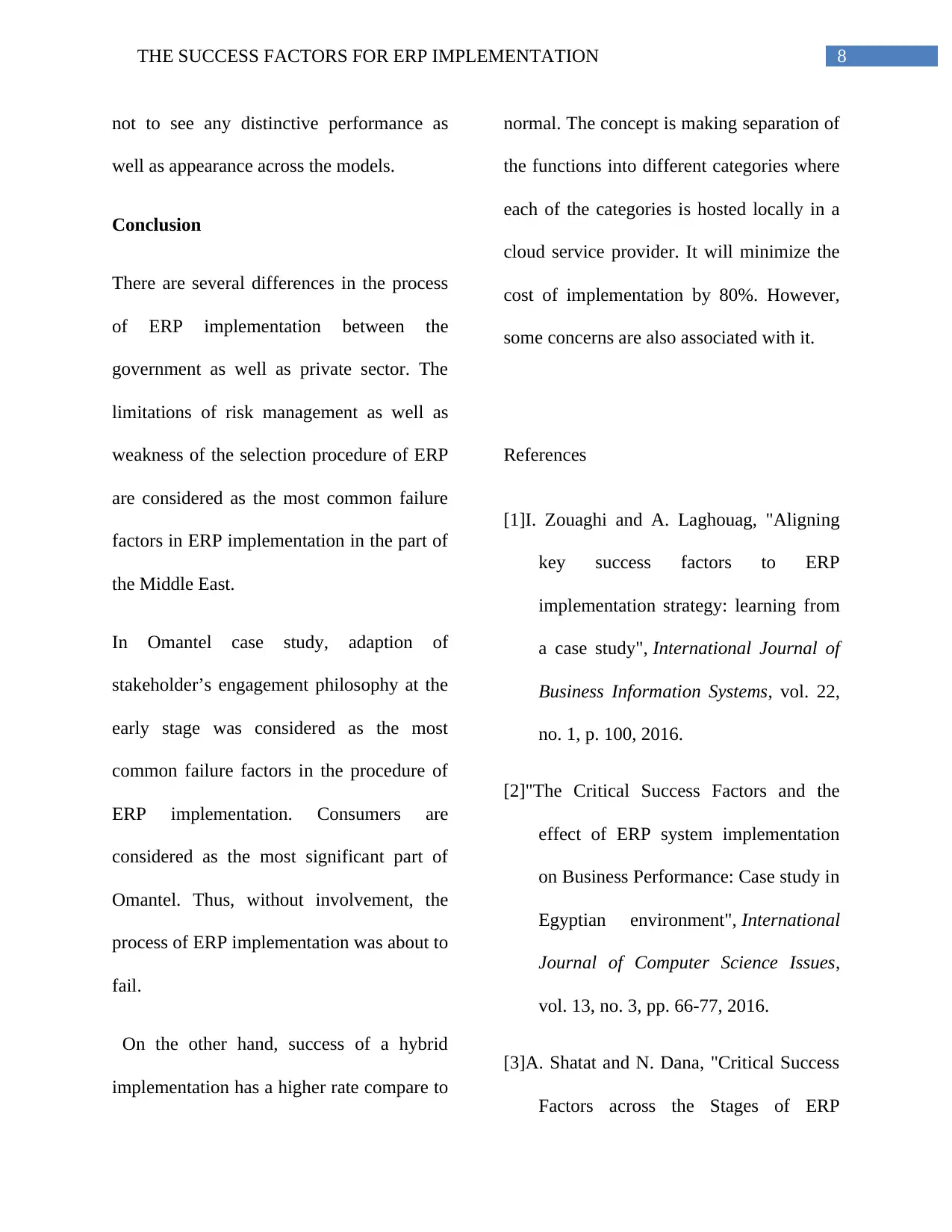
8THE SUCCESS FACTORS FOR ERP IMPLEMENTATION
not to see any distinctive performance as
well as appearance across the models.
Conclusion
There are several differences in the process
of ERP implementation between the
government as well as private sector. The
limitations of risk management as well as
weakness of the selection procedure of ERP
are considered as the most common failure
factors in ERP implementation in the part of
the Middle East.
In Omantel case study, adaption of
stakeholder’s engagement philosophy at the
early stage was considered as the most
common failure factors in the procedure of
ERP implementation. Consumers are
considered as the most significant part of
Omantel. Thus, without involvement, the
process of ERP implementation was about to
fail.
On the other hand, success of a hybrid
implementation has a higher rate compare to
normal. The concept is making separation of
the functions into different categories where
each of the categories is hosted locally in a
cloud service provider. It will minimize the
cost of implementation by 80%. However,
some concerns are also associated with it.
References
[1]I. Zouaghi and A. Laghouag, "Aligning
key success factors to ERP
implementation strategy: learning from
a case study", International Journal of
Business Information Systems, vol. 22,
no. 1, p. 100, 2016.
[2]"The Critical Success Factors and the
effect of ERP system implementation
on Business Performance: Case study in
Egyptian environment", International
Journal of Computer Science Issues,
vol. 13, no. 3, pp. 66-77, 2016.
[3]A. Shatat and N. Dana, "Critical Success
Factors across the Stages of ERP
not to see any distinctive performance as
well as appearance across the models.
Conclusion
There are several differences in the process
of ERP implementation between the
government as well as private sector. The
limitations of risk management as well as
weakness of the selection procedure of ERP
are considered as the most common failure
factors in ERP implementation in the part of
the Middle East.
In Omantel case study, adaption of
stakeholder’s engagement philosophy at the
early stage was considered as the most
common failure factors in the procedure of
ERP implementation. Consumers are
considered as the most significant part of
Omantel. Thus, without involvement, the
process of ERP implementation was about to
fail.
On the other hand, success of a hybrid
implementation has a higher rate compare to
normal. The concept is making separation of
the functions into different categories where
each of the categories is hosted locally in a
cloud service provider. It will minimize the
cost of implementation by 80%. However,
some concerns are also associated with it.
References
[1]I. Zouaghi and A. Laghouag, "Aligning
key success factors to ERP
implementation strategy: learning from
a case study", International Journal of
Business Information Systems, vol. 22,
no. 1, p. 100, 2016.
[2]"The Critical Success Factors and the
effect of ERP system implementation
on Business Performance: Case study in
Egyptian environment", International
Journal of Computer Science Issues,
vol. 13, no. 3, pp. 66-77, 2016.
[3]A. Shatat and N. Dana, "Critical Success
Factors across the Stages of ERP
⊘ This is a preview!⊘
Do you want full access?
Subscribe today to unlock all pages.

Trusted by 1+ million students worldwide
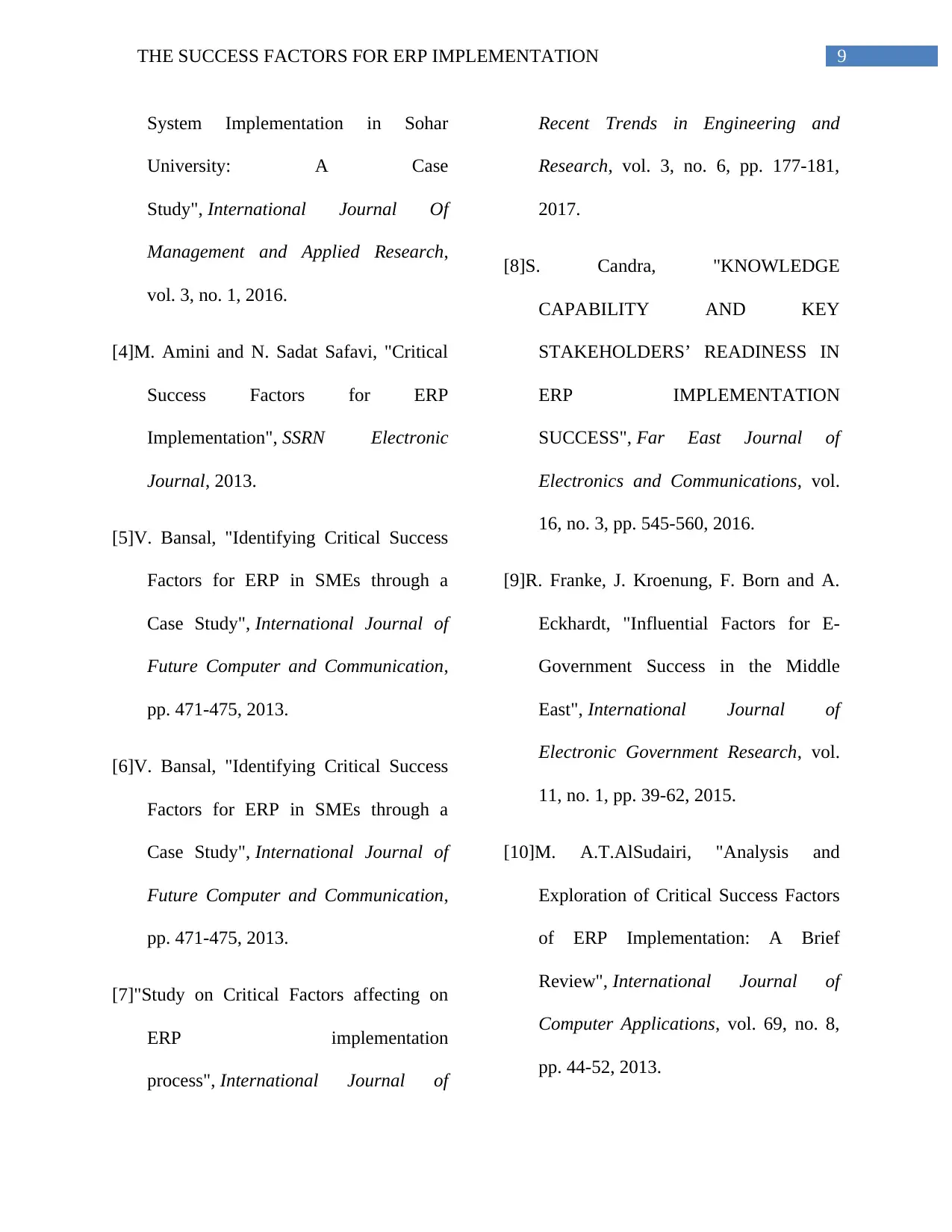
9THE SUCCESS FACTORS FOR ERP IMPLEMENTATION
System Implementation in Sohar
University: A Case
Study", International Journal Of
Management and Applied Research,
vol. 3, no. 1, 2016.
[4]M. Amini and N. Sadat Safavi, "Critical
Success Factors for ERP
Implementation", SSRN Electronic
Journal, 2013.
[5]V. Bansal, "Identifying Critical Success
Factors for ERP in SMEs through a
Case Study", International Journal of
Future Computer and Communication,
pp. 471-475, 2013.
[6]V. Bansal, "Identifying Critical Success
Factors for ERP in SMEs through a
Case Study", International Journal of
Future Computer and Communication,
pp. 471-475, 2013.
[7]"Study on Critical Factors affecting on
ERP implementation
process", International Journal of
Recent Trends in Engineering and
Research, vol. 3, no. 6, pp. 177-181,
2017.
[8]S. Candra, "KNOWLEDGE
CAPABILITY AND KEY
STAKEHOLDERS’ READINESS IN
ERP IMPLEMENTATION
SUCCESS", Far East Journal of
Electronics and Communications, vol.
16, no. 3, pp. 545-560, 2016.
[9]R. Franke, J. Kroenung, F. Born and A.
Eckhardt, "Influential Factors for E-
Government Success in the Middle
East", International Journal of
Electronic Government Research, vol.
11, no. 1, pp. 39-62, 2015.
[10]M. A.T.AlSudairi, "Analysis and
Exploration of Critical Success Factors
of ERP Implementation: A Brief
Review", International Journal of
Computer Applications, vol. 69, no. 8,
pp. 44-52, 2013.
System Implementation in Sohar
University: A Case
Study", International Journal Of
Management and Applied Research,
vol. 3, no. 1, 2016.
[4]M. Amini and N. Sadat Safavi, "Critical
Success Factors for ERP
Implementation", SSRN Electronic
Journal, 2013.
[5]V. Bansal, "Identifying Critical Success
Factors for ERP in SMEs through a
Case Study", International Journal of
Future Computer and Communication,
pp. 471-475, 2013.
[6]V. Bansal, "Identifying Critical Success
Factors for ERP in SMEs through a
Case Study", International Journal of
Future Computer and Communication,
pp. 471-475, 2013.
[7]"Study on Critical Factors affecting on
ERP implementation
process", International Journal of
Recent Trends in Engineering and
Research, vol. 3, no. 6, pp. 177-181,
2017.
[8]S. Candra, "KNOWLEDGE
CAPABILITY AND KEY
STAKEHOLDERS’ READINESS IN
ERP IMPLEMENTATION
SUCCESS", Far East Journal of
Electronics and Communications, vol.
16, no. 3, pp. 545-560, 2016.
[9]R. Franke, J. Kroenung, F. Born and A.
Eckhardt, "Influential Factors for E-
Government Success in the Middle
East", International Journal of
Electronic Government Research, vol.
11, no. 1, pp. 39-62, 2015.
[10]M. A.T.AlSudairi, "Analysis and
Exploration of Critical Success Factors
of ERP Implementation: A Brief
Review", International Journal of
Computer Applications, vol. 69, no. 8,
pp. 44-52, 2013.
Paraphrase This Document
Need a fresh take? Get an instant paraphrase of this document with our AI Paraphraser
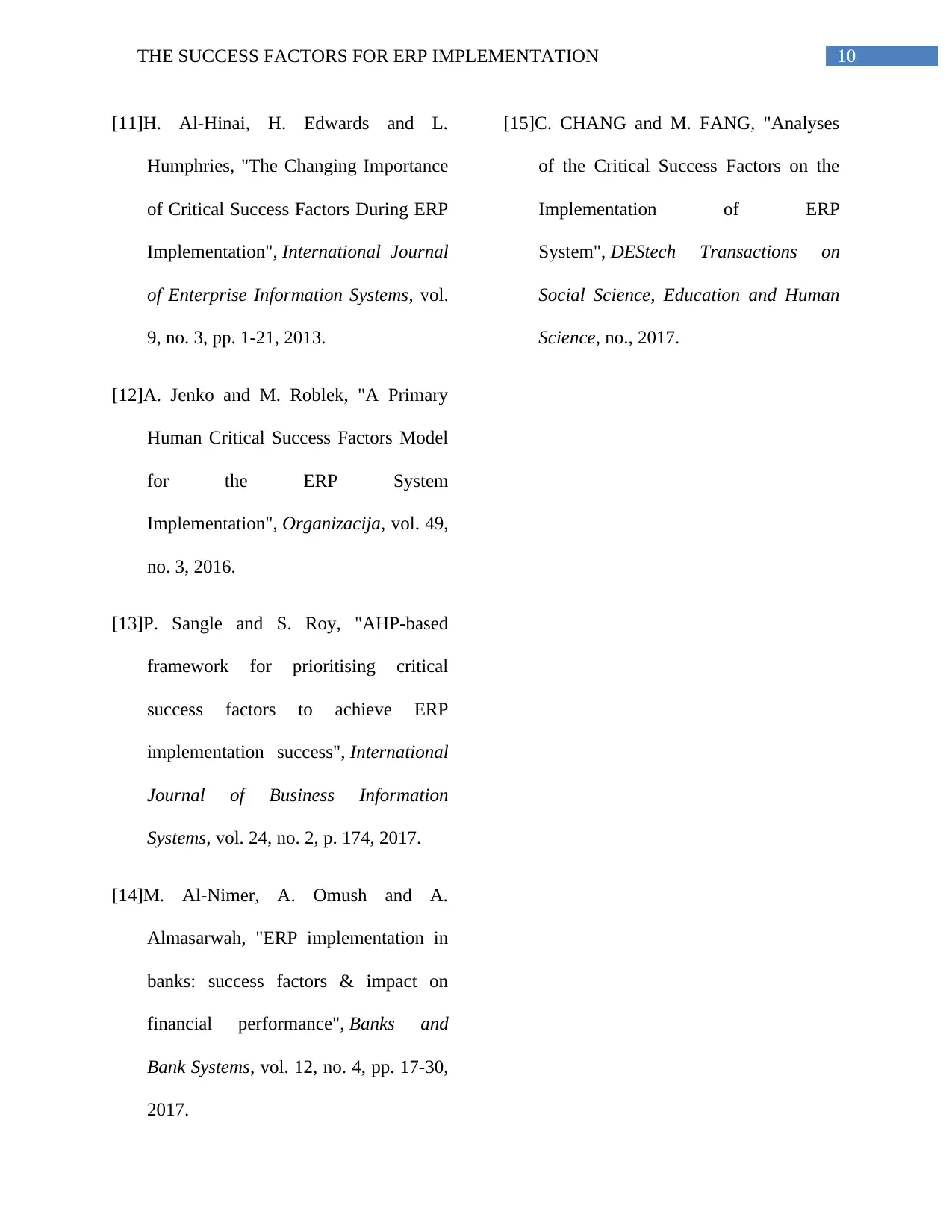
10THE SUCCESS FACTORS FOR ERP IMPLEMENTATION
[11]H. Al-Hinai, H. Edwards and L.
Humphries, "The Changing Importance
of Critical Success Factors During ERP
Implementation", International Journal
of Enterprise Information Systems, vol.
9, no. 3, pp. 1-21, 2013.
[12]A. Jenko and M. Roblek, "A Primary
Human Critical Success Factors Model
for the ERP System
Implementation", Organizacija, vol. 49,
no. 3, 2016.
[13]P. Sangle and S. Roy, "AHP-based
framework for prioritising critical
success factors to achieve ERP
implementation success", International
Journal of Business Information
Systems, vol. 24, no. 2, p. 174, 2017.
[14]M. Al-Nimer, A. Omush and A.
Almasarwah, "ERP implementation in
banks: success factors & impact on
financial performance", Banks and
Bank Systems, vol. 12, no. 4, pp. 17-30,
2017.
[15]C. CHANG and M. FANG, "Analyses
of the Critical Success Factors on the
Implementation of ERP
System", DEStech Transactions on
Social Science, Education and Human
Science, no., 2017.
[11]H. Al-Hinai, H. Edwards and L.
Humphries, "The Changing Importance
of Critical Success Factors During ERP
Implementation", International Journal
of Enterprise Information Systems, vol.
9, no. 3, pp. 1-21, 2013.
[12]A. Jenko and M. Roblek, "A Primary
Human Critical Success Factors Model
for the ERP System
Implementation", Organizacija, vol. 49,
no. 3, 2016.
[13]P. Sangle and S. Roy, "AHP-based
framework for prioritising critical
success factors to achieve ERP
implementation success", International
Journal of Business Information
Systems, vol. 24, no. 2, p. 174, 2017.
[14]M. Al-Nimer, A. Omush and A.
Almasarwah, "ERP implementation in
banks: success factors & impact on
financial performance", Banks and
Bank Systems, vol. 12, no. 4, pp. 17-30,
2017.
[15]C. CHANG and M. FANG, "Analyses
of the Critical Success Factors on the
Implementation of ERP
System", DEStech Transactions on
Social Science, Education and Human
Science, no., 2017.
1 out of 11
Related Documents
Your All-in-One AI-Powered Toolkit for Academic Success.
+13062052269
info@desklib.com
Available 24*7 on WhatsApp / Email
![[object Object]](/_next/static/media/star-bottom.7253800d.svg)
Unlock your academic potential
Copyright © 2020–2025 A2Z Services. All Rights Reserved. Developed and managed by ZUCOL.





